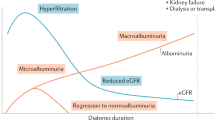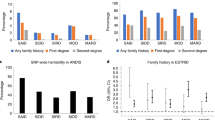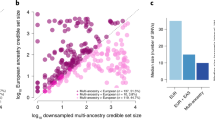Abstract
Our understanding of the genetics of type 2 diabetes mellitus (T2DM) has changed, in part owing to implementation of genome-wide association studies as a method for unraveling the genetic architecture of complex traits. These studies enable a global search throughout the nuclear genome for variants that are associated with specific phenotypes. Currently, single nucleotide polymorphisms in about 24 different genetic loci have been associated with T2DM. Most of these genetic loci are associated with the insulin secretion pathway rather than insulin resistance. Study design, heritability differences and the intrinsic properties of in vivo insulin resistance measures might partially explain why only a few loci associated with insulin resistance have been detected through genome-wide association approaches. Despite the success of these approaches at detecting loci associated with T2DM, currently known associations explain only a small amount of the genetic variance involved in the disease. Compared with previous studies, larger cohorts might be needed to identify variants of smaller effect sizes and lower allele frequencies. Finally, the current list of genetic loci that are related to T2DM does not seem to offer greater predictive value in determining diabetes risk than do commonly used phenotypic risk factors and family history.
Key Points
-
Family and twin studies have demonstrated that type 2 diabetes mellitus has a substantial genetic component
-
Linkage analysis can be useful to find mutations that cause monogenic diabetes, such as maturity-onset diabetes of the young
-
Genome-wide association studies have been useful as a global screen for loci that might be involved in common forms of type 2 diabetes mellitus
-
Most of the diabetes-related genes that have been discovered so far seem to be involved in insulin secretion, not insulin resistance
-
Incorporation of the currently known diabetes-related polymorphisms into diabetes prediction models does not markedly improve their predictive ability compared with commonly measured phenotypic risk factors and family history
This is a preview of subscription content, access via your institution
Access options
Subscribe to this journal
Receive 12 print issues and online access
$209.00 per year
only $17.42 per issue
Buy this article
- Purchase on Springer Link
- Instant access to full article PDF
Prices may be subject to local taxes which are calculated during checkout


Similar content being viewed by others
References
Centers for Disease Control and Prevention. DIABETES—Successes and Opportunities for Population-Based Prevention and Control: At A Glance 2009 Chronic Disease Prevention and Health Promotion [online]. (2009).
Moore, A. F. & Florez, J. C. Genetic susceptibility to type 2 diabetes and implications for antidiabetic therapy. Annu. Rev. Med. 59, 95–111 (2008).
Barnett, A. H., Eff, C., Leslie, R. D. & Pyke, D. A. Diabetes in identical twins. A study of 200 pairs. Diabetologia 20, 87–93 (1981).
Ghosh, S. & Schork, N. Genetic analysis of NIDDM. The study of quantitative traits. Diabetes 45, 1–14 (1996).
Neel, J. Diabetes mellitus—a geneticist's nightmare. In The Genetics of Diabetes Mellitus (Eds Creutzfeldt, W. et al.) 1–11 (Springer, New York, 1976).
Fajans, S. S., Bell, G. I. & Polonsky, K. S. Molecular mechanisms and clinical pathophysiology of maturity-onset diabetes of the young. N. Engl. J. Med. 345, 971–980 (2001).
Altshuler, D. et al. The common PPARγ Pro12Ala polymorphism is associated with decreased risk of type 2 diabetes. Nat. Genet. 26, 76–80 (2000).
Gloyn, A. L. et al. Large-scale association studies of variants in genes encoding the pancreatic β-cell KATP channel subunits Kir6.2 (KCNJ11) and SUR1 (ABCC8) confirm that the KCNJ11 E23K variant is associated with type 2 diabetes. Diabetes 52, 568–572 (2003).
Florez, J. C. et al. Haplotype structure and genotype-phenotype correlations of the sulfonylurea receptor and the islet ATP-sensitive potassium channel gene region. Diabetes 53, 1360–1368 (2004).
Nielsen E.-M. D. et al. The E23K variant of Kir6.2 associates with impaired post-OGTT serum insulin response and increased risk of type 2 diabetes. Diabetes 52, 573–577 (2003).
Grant, S. F. et al. Variant of transcription factor 7-like 2 (TCF7L2) gene confers risk of type 2 diabetes. Nat. Genet. 38, 320–323 (2006).
Cauchi, S. et al. TCF7L2 is reproducibly associated with type 2 diabetes in various ethnic groups: a global meta-analysis. J. Mol. Med. 85, 777–782 (2007).
Florez, J. C. The new type 2 diabetes gene TCF7L2. Curr. Opin. Clin. Nutr. Metab. Care 10, 391–396 (2007).
Helgason, A. et al. Refining the impact of TCF7L2 gene variants on type 2 diabetes and adaptive evolution. Nat. Genet. 39, 218–225 (2007).
Inoue, H. et al. A gene encoding a transmembrane protein is mutated in patients with diabetes mellitus and optic atrophy (Wolfram syndrome). Nat. Genet. 20, 143–148 (1998).
Sandhu, M. S. et al. Common variants in WFS1 confer risk of type 2 diabetes. Nat. Genet. 39, 951–953 (2007).
Bonnycastle, L. L. et al. Common variants in maturity-onset diabetes of the young genes contribute to risk of type 2 diabetes in Finns. Diabetes 55, 2534–2540 (2006).
Winckler, W. et al. Association of common variation in the HNF1α gene region with risk of type 2 diabetes. Diabetes 54, 2336–2342 (2005).
Winckler, W. et al. Association testing of variants in the hepatocyte nuclear factor 4α gene with risk of type 2 diabetes in 7,883 people. Diabetes 54, 886–892 (2005).
Winckler, W. et al. Evaluation of common variants in the six known Maturity-Onset Diabetes of the Young (MODY) genes for association with type 2 diabetes. Diabetes 56, 685–693 (2007).
Gudmundsson, J. et al. Two variants on chromosome 17 confer prostate cancer risk, and the one in TCF2 protects against type 2 diabetes. Nat. Genet. 39, 977–983 (2007).
The International HapMap Consortium. A haplotype map of the human genome. Nature 437, 1299–1320 (2005).
Hirschhorn, J. N., Lohmueller, K., Byrne, E. & Hirschhorn, K. A comprehensive review of genetic association studies. Genet. Med. 4, 45–61 (2002).
Ioannidis, J. P., Ntzani, E. E., Trikalinos, T. A. & Contopoulos-Ioannidis, D. G. Replication validity of genetic association studies. Nat. Genet. 29, 306–309 (2001).
Lander, E. S. et al. Initial sequencing and analysis of the human genome. Nature 409, 860–921 (2001).
Sachidanandam, R. et al. A map of human genome sequence variation containing 1.42 million single nucleotide polymorphisms. Nature 409, 928–933 (2001).
The International HapMap Consortium. The International HapMap Project. Nature 426, 789–796 (2003).
The International HapMap Consortium. A second generation human haplotype map of over 3.1 million SNPs. Nature 449, 851–861 (2007).
Sladek, R. et al. A genome-wide association study identifies novel risk loci for type 2 diabetes. Nature 445, 881–885 (2007).
Chimienti, F., Devergnas, S., Favier, A. & Seve, M. Identification and cloning of a β-cell-specific zinc transporter, ZnT-8, localized into insulin secretory granules. Diabetes 53, 2330–2337 (2004).
Frayling, T. M. Genome-wide association studies provide new insights into type 2 diabetes aetiology. Nat. Rev. Genet. 8, 657–662 (2007).
Diabetes Genetics Initiative of Broad Institute of Harvard and MIT, Lund University and Novartis Institutes of BioMedical Research. Genome-wide association analysis identifies loci for type 2 diabetes and triglyceride levels. Science 316, 1331–1336 (2007).
Zeggini, E. et al. Replication of genome-wide association signals in UK samples reveals risk loci for type 2 diabetes. Science 316, 1336–1341 (2007).
Scott, L. J. et al. A genome-wide association study of type 2 diabetes in Finns detects multiple susceptibility variants. Science 316, 1341–1345 (2007).
Steinthorsdottir, V. et al. A variant in CDKAL1 influences insulin response and risk of type 2 diabetes. Nat. Genet. 39, 770–775 (2007).
Zeggini, E. et al. Meta-analysis of genome-wide association data and large-scale replication identifies additional susceptibility loci for type 2 diabetes. Nat. Genet. 40, 638–645 (2008).
Unoki, H. et al. SNPs in KCNQ1 are associated with susceptibility to type 2 diabetes in East Asian and European populations. Nat. Genet. 40, 1098–1102 (2008).
Yasuda, K. et al. Variants in KCNQ1 are associated with susceptibility to type 2 diabetes mellitus. Nat. Genet. 40, 1092–1097 (2008).
Weedon, M. N. et al. A common haplotype of the glucokinase gene alters fasting glucose and birth weight: association in six studies and population-genetics analyses. Am. J. Hum. Genet. 79, 991–1001 (2006).
Gloyn, A. L. Glucokinase (GCK) mutations in hyper- and hypoglycemia: maturity-onset diabetes of the young, permanent neonatal diabetes, and hyperinsulinemia of infancy. Hum. Mutat. 22, 353–362 (2003).
Bouatia-Naji, N. et al. A polymorphism within the G6PC2 gene is associated with fasting plasma glucose levels. Science 320, 1085–1088 (2008).
Chen, W. M. et al. Variations in the G6PC2/ABCB11 genomic region are associated with fasting glucose levels. J. Clin. Invest. 118, 2620–2628 (2008).
Hu, C. et al. A genetic variant of G6PC2 is associated with type 2 diabetes and fasting plasma glucose level in the Chinese population. Diabetologia 52, 451–456 (2009).
Bouatia-Naji, N. et al. A variant near MTNR1B is associated with increased fasting plasma glucose levels and type 2 diabetes risk. Nat. Genet. 41, 89–94 (2009).
Lyssenko, V. et al. Common variant in MTNR1B associated with increased risk of type 2 diabetes and impaired early insulin secretion. Nat. Genet. 41, 82–88 (2009).
Prokopenko, I. et al. Variants in MTNR1B influence fasting glucose levels. Nat. Genet. 41, 77–81 (2009).
Florez, J. C. Newly identified loci highlight beta cell dysfunction as a key cause of type 2 diabetes: where are the insulin resistance genes? Diabetologia 51, 1100–1110 (2008).
Barroso, I. et al. Population-specific risk of type 2 diabetes conferred by HNF4A P2 promoter variants: a lesson for replication studies. Diabetes 57, 3161–3165 (2008).
Love-Gregory, L. D. et al. A common polymorphism in the upstream promoter region of the hepatocyte nuclear factor-4α gene on chromosome 20q is associated with type 2 diabetes and appears to contribute to the evidence for linkage in an Ashkenazi Jewish population. Diabetes 53, 1134–1140 (2004).
Silander, K. et al. Genetic variation near the hepatocyte nuclear factor-4α gene predicts susceptibility to type 2 diabetes. Diabetes 53, 1141–1149 (2004).
Gloyn, A. L. et al. Activating mutations in the gene encoding the ATP-sensitive potassium-channel subunit Kir6.2 and permanent neonatal diabetes. N. Engl. J. Med. 350, 1838–1849 (2004).
Florez, J. C. et al. TCF7L2 polymorphisms and progression to diabetes in the Diabetes Prevention Program. N. Engl. J. Med. 355, 241–250 (2006).
Saxena, R. et al. Common single nucleotide polymorphisms in TCF7L2 are reproducibly associated with type 2 diabetes and reduce the insulin response to glucose in nondiabetic individuals. Diabetes 55, 2890–2895 (2006).
Gonzalez-Sanchez, J. et al. Association of variants of the TCF7L2 gene with increases in the risk of type 2 diabetes and the proinsulin:insulin ratio in the Spanish population. Diabetologia 51, 1993–1997 (2008).
Kirchhoff, K. et al. Polymorphisms in the TCF7L2, CDKAL1, and SLC30A8 genes are associated with impaired proinsulin conversion. Diabetologia 51, 597–601 (2008).
Loos, R. J. et al. TCF7L2 polymorphisms modulate proinsulin levels and β-cell function in a British Europid population. Diabetes 56, 1943–1947 (2007).
Stolerman, E. S. et al. TCF7L2 variants are associated with increased proinsulin/insulin ratios but not obesity traits in the Framingham Heart Study. Diabetologia 52, 614–620 (2009).
Grarup, N. et al. Association testing of novel type 2 diabetes risk alleles in the JAZF1, CDC123/CAMK1D, TSPAN8, THADA, ADAMTS9, and NOTCH2 loci with insulin release, insulin sensitivity, and obesity in a population-based sample of 4,516 glucose-tolerant middle-aged Danes. Diabetes 57, 2534–2540 (2008).
Grarup, N. et al. Studies of association of variants near the HHEX, CDKN2A/B, and IGF2BP2 genes with type 2 diabetes and impaired insulin release in 10,705 Danish subjects: validation and extension of genome-wide association studies. Diabetes 56, 3105–3111 (2007).
Pascoe, L. et al. Common variants of the novel type 2 diabetes genes CDKAL1 and HHEX/IDE are associated with decreased pancreatic β-cell function. Diabetes 56, 3101–3104 (2007).
Sparso, T. et al. Impact of polymorphisms in WFS1 on prediabetic phenotypes in a population-based samples of middle-aged people with normal and abnormal glucose regulation. Diabetologia 51, 1646–1652 (2008).
Staiger, H. et al. Polymorphisms within novel risk loci for type 2 diabetes determine β-cell function. PLoS ONE 2, e832 (2007).
Panhuysen, C. I. et al. A genome scan for loci linked to quantitative insulin traits in persons without diabetes: the Framingham Offspring Study. Diabetologia 46, 579–587 (2003).
Frayling, T. M. et al. A common variant in the FTO gene is associated with body mass index and predisposes to childhood and adult obesity. Science 316, 889–894 (2007).
Freathy, R. M. et al. Common variation in the FTO gene alters diabetes-related metabolic traits to the extent expected given its effect on BMI. Diabetes 57, 1419–1426 (2008).
Grunnet, L. G. et al. Increased recovery rates of phosphocreatine and inorganic phosphate after isometric contraction in oxidative muscle fibres and elevated hepatic insulin resistance in homozygous carriers of the A-allele of FTO rs9939609. J. Clin. Endocrinol. Metab. 94, 596–602 (2008).
Jacobsson, J. A. et al. Novel genetic variant in FTO influences insulin levels and insulin resistance in severely obese children and adolescents. Int. J. Obes. 32, 1730–1735 (2008).
Barroso, I. et al. Dominant negative mutations in human PPARγ associated with severe insulin resistance, diabetes mellitus and hypertension. Nature 402, 880–883 (1999).
Pearson, E. R. et al. Genetic cause of hyperglycaemia and response to treatment in diabetes. Lancet 362, 1275–1281 (2003).
Nathan, D. M. et al. Medical management of hyperglycemia in type 2 diabetes: a consensus algorithm for the initiation and adjustment of therapy: a consensus statement of the American Diabetes Association and the European Association for the Study of Diabetes. Diabetes Care 32, 193–203 (2009).
Pearson, E. R. et al. Switching from insulin to oral sulfonylureas in patients with diabetes due to Kir6.2 mutations. N. Engl. J. Med. 355, 467–477 (2006).
Babenko, A. P. et al. Activating mutations in the ABCC8 gene in neonatal diabetes mellitus. N. Engl. J. Med. 355, 456–466 (2006).
Shu, Y. et al. Effect of genetic variation in the organic cation transporter 1 (OCT1) on metformin action. J. Clin. Invest. 117, 1422–1431 (2007).
Zhou, K. et al. Reduced-function SLC22A1 polymorphisms encoding organic cation transporter 1 and glycemic response to metformin: a GoDARTS study. Diabetes 58, 1434–1439 (2009).
Becker, M. L. et al. Genetic variation in the multidrug and toxin extrusion 1 transporter protein influences the glucose-lowering effect of metformin in patients with diabetes: a preliminary study. Diabetes 58, 745–749 (2009).
Pearson, E. R. et al. Variation in TCF7L2 influences therapeutic response to sulfonylureas: a GoDARTs study. Diabetes 56, 2178–2182 (2007).
Feng, Y. et al. Ser1369Ala variant in sulfonylurea receptor gene ABCC8 is associated with antidiabetic efficacy of gliclazide in Chinese type 2 diabetic patients. Diabetes Care 31, 1939–1944 (2008).
Wilson, P. W. et al. Prediction of incident diabetes mellitus in middle-aged adults: the Framingham Offspring Study. Arch. Intern. Med. 167, 1068–1074 (2007).
Meigs, J. B. et al. Genotype score in addition to common risk factors for prediction of type 2 diabetes. N. Engl. J. Med. 359, 2208–2219 (2008).
Lyssenko, V. et al. Clinical risk factors, DNA variants, and the development of type 2 diabetes. N. Engl. J. Med. 359, 2220–2232 (2008).
van Hoek, M. et al. Predicting type 2 diabetes based on polymorphisms from genome-wide association studies: a population-based study. Diabetes 57, 3122–3128 (2008).
Lango, H. et al. Assessing the combined impact of 18 common genetic variants of modest effect sizes on type 2 diabetes risk. Diabetes 57, 3129–3135 (2008).
Frayling, T. M. Genome-wide association studies provide new insights into type 2 diabetes aetiology. Nat. Rev. Genet. 8, 657–662 (2007).
Ludovico, O. et al. Heterogeneous effect of peroxisome proliferator-activated receptor γ2 Ala12 variant on type 2 diabetes risk. Obesity (Silver Spring) 15, 1076–1081 (2007).
Acknowledgements
E. S. Stolerman is supported by NIH Training Grant T32 GM007748 in Genetics. J. C. Florez is supported by a Physician Scientist Development Award by the Massachusetts General Hospital and a Clinical Scientist Development Award from the Doris Duke Charitable Foundation.
Author information
Authors and Affiliations
Corresponding author
Ethics declarations
Competing interests
J. C. Florez declares having received one-time consulting fees from the following companies: Merck, Pfizer, bioStrategies Group, XOMA and Publicis Healthcare Communications Group (engaged by Amylin Pharmaceuticals). E. S. Stolerman declares no competing interests.
Rights and permissions
About this article
Cite this article
Stolerman, E., Florez, J. Genomics of type 2 diabetes mellitus: implications for the clinician. Nat Rev Endocrinol 5, 429–436 (2009). https://doi.org/10.1038/nrendo.2009.129
Published:
Issue Date:
DOI: https://doi.org/10.1038/nrendo.2009.129
This article is cited by
-
Differential contribution of alpha and beta cell dysfunction to impaired fasting glucose and impaired glucose tolerance
Diabetologia (2023)
-
Development and validation of a predictive model for incident type 2 diabetes in middle-aged Mexican adults: the metabolic syndrome cohort
BMC Endocrine Disorders (2019)
-
Role of rs6923761 gene variant in glucagon-like peptide 1 receptor in basal GLP-1 levels, cardiovascular risk factor and serum adipokine levels in naïve type 2 diabetic patients
Journal of Endocrinological Investigation (2015)
-
The Effect of Genetic Counseling for Adult Offspring of Patients with Type 2 Diabetes on Attitudes Toward Diabetes and its Heredity: A Randomized Controlled Trial
Journal of Genetic Counseling (2014)
-
Osteocalcin and the Regulation of Glucose Metabolism
Clinical Reviews in Bone and Mineral Metabolism (2013)



